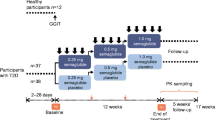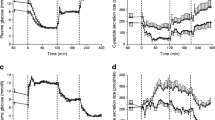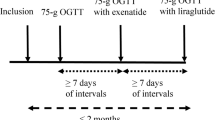Summary
Of 23 patients with non-insulin-dependent diabetes mellitus (NIDDM), whose fasting blood glucose had not reached ≤6.0 mmol·l−1 after 10 weeks of dietary regulation, 15, who had had a weight reduction of −2.8 kg by dietary control, did achieve a fasting blood glucose ≤6.0 mmol·l−1 after addition of ≤20 mg glipizide daily. They had a sustained (≥2 years) increase in meal-induced insulin secretion (32% increase in postprandial C-peptide AUC), and a sustained reduction in postprandial hyperglycaemia (34% reduction in AUC). Ten of the patients took a mean daily dose <5mg (4.8 mg) and had a sustained increase in insulin secretion rate (increased C-peptide slope). The 15 patients had no elevation of basal insulin secretion and no impairment of weight reduction. The remaining 8 subjects, who showed little or no weight reduction on dietary control, had little or no reduction in fasting blood glucose despite long-term treatment with 20 mg glipizide daily, a less sustained increase in meal-induced insulin secretion, a smaller reduction of postprandial hyperglycaemia, and an increase in body weight. On diagnosis the 8 subjects did not differ from the other 15 subjects in age, body weight, blood glucose, HbA1c, C-peptide or insulin, nor in their glucose and insulin responses to a test dose of glipizide; the main reason for the apparent drug failure appeared to be deficient compliance with dietary regulation rather than a primary inability to respond to sulphonylurea treatment. The findings indicate that glipizide is able to promote and maintain increased meal-induced insulin secretion and near-normal fasting and non-fasting blood glucose levels without continuous B cell stimulation. However, these improvements prevail mainly in subjects who persist with hypocaloric dietary regulation.
Similar content being viewed by others
References
Wood FC Jr, Biermann EL (1986) Is diet the cornerstone in management of diabetes? N Engl J Med 315: 1224–1227
Multi-centre study (1983) UK prospective study of therapies of maturity-onset diabetes. 1. Effect of diet, sulfonylurea, insulin or biguanide therapy on fasting plasma glucose and body weight over one year. Diabetologia 24: 404–411
Hadden DR, Blair ALT, Wilson EA, Boyle DMcC, Atkinson AB, Kennedy AL, Buchanan KD, Merrett JD, Montgomery DAD, Weaver JA (1986) Natural history of diabetes presenting age 40–69 years: a prospective study of the influence of intensive dietary therapy. Q J Med 230: 579–598
Bitzén P-O, Melander A, Scherstén B, Svensson M (1988) Efficacy of dietary regulation in primary health care patients with screening-detected hyperglycaemia. Diab Med 5: 640–647
Cerasi E, Efendić S, Luft R (1973) Dose-response relation between plasma-insulin and blood-glucose levels during oral glucose loads in pre-diabetic and diabetic subjects. Lancet I: 794–797
Kosaka K, Hagura R, Kuzuya T (1977) Insulin response in equivocal and definite diabetes, with special reference to subjects who had mild glucose intolerance but later developed definite diabetes. Diabetes 26: 944–952
Eriksson J, Franssila-Kallunki A, Ekstrand A, Saloranta C, Widén E, Schalin C, Groop L (1989) Early metabolic defects in persons at increased risk for non-insulin-dependent diabetes mellitus. N Engl J Med 321: 337–343
Temple RC, Carrington CA, Luzio SD, Owens DR, Schneider AE, Sobey WJ, Hales NC (1989) Insulin deficiency in non-insulin-dependent diabetes. Lancet I: 293–295
Bitzén P-O, Melander A, Scherstén B, W»hlin-Boll E (1988) The influence of glipizide on early insulin release and glucose disposal before and after dietary regulation in diabetic patients with different degrees of hyperglycaemia. Eur J Clin Pharmacol 35: 31–37
Bitzén P-O, Scherstén B (1986) Assessment of laboratory methods for detection of unsuspected diabetes in primary health care. Scand J Prim Health Care 4: 85–95
Ferner R, Rawlins MD, Alberti KGMM (1988) Impaired B-cell responses improve when fasting blood glucose concentration is reduced in non-insulin-dependent diabetes. Q J Med New Series 66: 137–146
Schmidt FH (1961) Die enzymatische Bestimmung von Glucose und Fructose nebeneinander. Klin Wochenschr 39: 1244–1247
Heding LG (1966) A simplified insulin radioimmunoassay method. In: Donato L, Milhaud G, Sirchis J (eds) Labelled proteins in tracter studies. Brussels, Euratom, pp 345–350
Heding LG (1975) Radioimmunological determination of human C-peptide in serum. Diabetologia 11: 541–548
W»hlin-Boll E, Melander A (1979) High performance liquid chromatographic determination of glipizide and some other sulfonylurea drugs in serum. J Chromatogr 164: 546
Almér L-O, Johansson E, Melander A, W»hlin-Boll E (1982) Influence of sulfonylureas on the secretion, disposal and effect of insulin. Eur J Clin Pharmacol 22: 27–32
Schen AJ, Lefèbvre PJ, Luycx AJ (1984) Glipizide increases plasma insulin but not C-peptide level after a standardized breakfast in type 2 diabetic patients. Eur J Clin Pharmacol 26: 471–474
Mulder H, Schopman W, Lely AJ van der (1991) Extrapancreatic insulin effect of glibenclamide. Eur J Clin Pharmacol 40: 379–381
Sartor G, Ursing D, Nilsson-Ehle P, W»hlin-Boll E, Melander A (1987) Lack of primary effect of sulphonylurea (glipizide) on plasma lipoproteins and insulin action in former type 2 diabetics with attenuated insulin secretion. Eur J Clin Pharmacol 33: 279–282
Unger RH, Grundy S (1985) Hyperglycaemia as an inducer as well as a consequence of impaired islet cell function and insulin resistance: implications for the management of diabetes. Diabetologia 28: 119–121
Liu GC, Coulston AM, Lardinois CK, Hollenbeck CB, More JG, Reaven GM (1985) Moderate weight loss and sulfonylurea treatment of non-insulin-dependent diabetes mellitus. Arch Intern Med 145: 665–669
Karam JH, Sanz N, Salamon E, Nolte MS (1986) Selective unresponsiveness of pancreatic B-cells to acute sulfonylurea stimulation during sulfonylurea therapy in NIDDM. Diabetes 35: 1314–1320
Groop L, Groop P-H, Stenman S, Saloranta C, Tötterman K-J, Fyhrquist F, Melander A (1987) Comparison of pharmacokinetics, metabolic effects and mechanisms of action of glyburide and glipizide during long-term treatment. Diabetes Care 10: 671–678
W»hlin-Boll E, Sartor G, Melander A, Scherstén B (1982) Impaired effect of sulfonylurea following increased dosage. Eur J Clin Pharmacol 22: 21–25
Author information
Authors and Affiliations
Rights and permissions
About this article
Cite this article
Bitzén, PO., Melander, A., Scherstén, B. et al. Long-term effects of glipizide on insulin secretion and blood glucose control in patients with non-insulin-dependent diabetes mellitus. Eur J Clin Pharmacol 42, 77–83 (1992). https://doi.org/10.1007/BF00314924
Received:
Accepted:
Issue Date:
DOI: https://doi.org/10.1007/BF00314924




